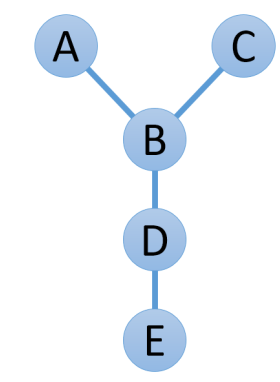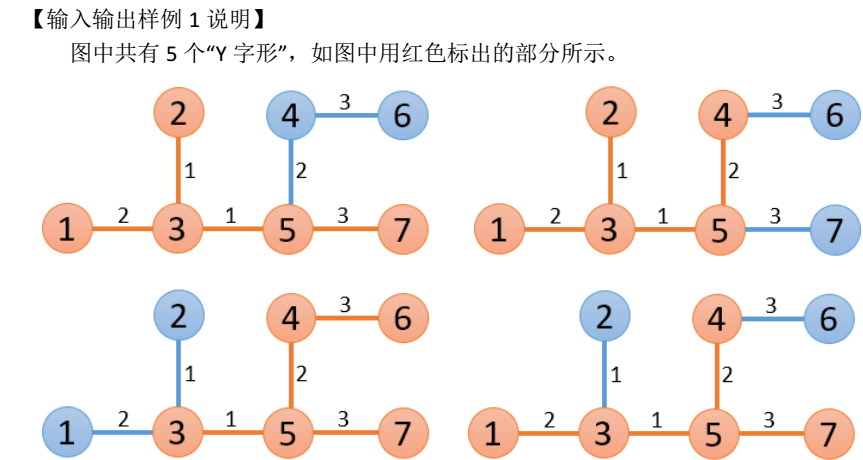noip模拟赛 小Y的问题
2017-10-27 09:09
351 查看
【问题描述】
有个孩子叫小 Y,一天,小 Y 拿到了一个包含 n 个点和 n-1 条边的无向连通图, 图中的
点用 1~n 的整数编号。小 Y 突发奇想,想要数出图中有多少个“Y 字形”。
一个“Y 字形”由 5 个不同的顶点 A、 B、 C、 D、 E 以及它们之间的 4 条边组成,其中 AB、
BC、 BD、 DE 之间有边相连, 如下图所示。

同时,无向图中的每条边都是有一定长度的。一个“Y 字形”的长度定义为构成它的四条
边的长度和。小 Y 也想知道,图中长度最大的“Y 字形”长度是多少。
【输入】
第一行包含一个整数 n,表示无向图的点数。
接下来 n 行, 每行有 3 个整数 x、 y、 z, 表示编号为 x 和 y 的点之间有一条长度为 z 的
边。
【输出】
输出包含 2 行。
第 1 行包含一个整数,表示图中的“Y 字形”的数量。
第 2 行包含一个整数,表示图中长度最大的“Y 字形”的长度。
【输入输出样例 1】


其中,长度最大的“Y 字形”是编号 3、 5、 7、 4、 6 的顶点构成的那一个,长度为 9。
【数据规模与约定】
对于 30%的数据, n≤10
对于 60%的数据, n≤2,000
对于 100%的数据, n≤200,000, 1≤x,y≤n, 1≤z≤10,000
分析:这道题很好啊.一开始我的思路错了,以为这是树形dp,推着推着发现情况太多,推不出来.
尝试打暴力,先考虑n<=10的点,枚举Y字形的5个点或者4条边都可以,不过最好还是枚举4条边,毕竟复杂度小一些.
60%的数据就只能枚举2个东西了,肯定是要枚举边的,枚举哪两条边呢?看哪条边最特殊、信息最多.枚举度数为3的点u和度数2的点v的中心边.然后扫一下与u相连除了v以外有多少个点x,前3大的边,对v进行同样的操作.方案数就是C(x,2) * y.对最大值的处理只需要讨论一下u,v那条边是第几大的,把另外的前3大的边加上就好了.
60%的算法瓶颈是每次枚举一条中心边后都要花O(n)的时间来找点和边,如果能把O(n)变小,变成O(logn)甚至是O(1)就好了.很显然,预处理一下就好了,整体复杂度降为了O(n),可以通过所有数据.
枚举题首先要看数据范围,可以知道大概要枚举多少层,枚举的对象最好选择信息最多的,如果重复枚举比较多,可以先预处理一下.
有个孩子叫小 Y,一天,小 Y 拿到了一个包含 n 个点和 n-1 条边的无向连通图, 图中的
点用 1~n 的整数编号。小 Y 突发奇想,想要数出图中有多少个“Y 字形”。
一个“Y 字形”由 5 个不同的顶点 A、 B、 C、 D、 E 以及它们之间的 4 条边组成,其中 AB、
BC、 BD、 DE 之间有边相连, 如下图所示。

同时,无向图中的每条边都是有一定长度的。一个“Y 字形”的长度定义为构成它的四条
边的长度和。小 Y 也想知道,图中长度最大的“Y 字形”长度是多少。
【输入】
第一行包含一个整数 n,表示无向图的点数。
接下来 n 行, 每行有 3 个整数 x、 y、 z, 表示编号为 x 和 y 的点之间有一条长度为 z 的
边。
【输出】
输出包含 2 行。
第 1 行包含一个整数,表示图中的“Y 字形”的数量。
第 2 行包含一个整数,表示图中长度最大的“Y 字形”的长度。
【输入输出样例 1】
| question.in | question.out |
| 7 1 3 2 2 3 1 3 5 1 5 4 2 4 6 3 5 7 3 | 5 9 |


其中,长度最大的“Y 字形”是编号 3、 5、 7、 4、 6 的顶点构成的那一个,长度为 9。
【数据规模与约定】
对于 30%的数据, n≤10
对于 60%的数据, n≤2,000
对于 100%的数据, n≤200,000, 1≤x,y≤n, 1≤z≤10,000
分析:这道题很好啊.一开始我的思路错了,以为这是树形dp,推着推着发现情况太多,推不出来.
尝试打暴力,先考虑n<=10的点,枚举Y字形的5个点或者4条边都可以,不过最好还是枚举4条边,毕竟复杂度小一些.
60%的数据就只能枚举2个东西了,肯定是要枚举边的,枚举哪两条边呢?看哪条边最特殊、信息最多.枚举度数为3的点u和度数2的点v的中心边.然后扫一下与u相连除了v以外有多少个点x,前3大的边,对v进行同样的操作.方案数就是C(x,2) * y.对最大值的处理只需要讨论一下u,v那条边是第几大的,把另外的前3大的边加上就好了.
60%的算法瓶颈是每次枚举一条中心边后都要花O(n)的时间来找点和边,如果能把O(n)变小,变成O(logn)甚至是O(1)就好了.很显然,预处理一下就好了,整体复杂度降为了O(n),可以通过所有数据.
枚举题首先要看数据范围,可以知道大概要枚举多少层,枚举的对象最好选择信息最多的,如果重复枚举比较多,可以先预处理一下.
#include <map>
#include <cmath>
#include <queue>
#include <cstdio>
#include <cstring>
#include <iostream>
#include <algorithm>
using namespace std;
typedef long long ll;
struct node
{
ll u, v, w;
}e[200010];
ll n, du[200010], max1[200010], max2[200010], max3[200010], ans;
ll sum;
void solve(ll x, ll y)
{
if (y > max1[x])
{
max3[x] = max2[x];
max2[x] = max1[x];
max1[x] = y;
}
else
if (y > max2[x])
{
max3[x] = max2[x];
max2[x] = y;
}
else
if (y > max3[x])
max3[x] = y;
}
int main()
{
scanf("%lld", &n);
for (int i = 1; i < n; i++)
{
scanf("%lld%lld%lld", &e[i].u, &e[i].v, &e[i].w);
du[e[i].u]++;
du[e[i].v]++;
solve(e[i].u, e[i].w);
solve(e[i].v, e[i].w);
}
for (int i = 1; i < n; i++)
{
ll u = e[i].u, v = e[i].v, w = e[i].w;
ll maxx = max(du[u], du[v]), minn = min(du[u], du[v]);
if (!(maxx >= 3 && minn >= 2))
continue;
if (du[u] > 2)
{
long long temp = (du[u] - 1) * (du[u] - 2) / 2;
temp *= (du[v] - 1);
sum += temp;
ll temp2, temp3;
temp2 = max1[u] + max2[u];
temp3 = max1[v];
if (w == max1[u])
temp2 = max2[u] + max3[u];
if (w == max2[u])
temp2 = max1[u] + max3[u];
if (w == max3[u])
temp2 = max1[u] + max2[u];
if (w == max1[v])
temp3 = max2[v];
else
temp3 = max1[v];
ans = max(ans, temp2 + temp3 + w);
}
swap(u, v);
if (du[u] > 2)
{
long long temp = (du[u] - 1) * (du[u] - 2) / 2;
temp *= (du[v] - 1);
sum += temp;
ll temp2, temp3;
temp2 = max1[u] + max2[u];
temp3 = max1[v];
if (w == max1[u])
temp2 = max2[u] + max3[u];
if (w == max2[u])
temp2 = max1[u] + max3[u];
if (w == max3[u])
temp2 = max1[u] + max2[u];
if (w == max1[v])
temp3 = max2[v];
else
temp3 = max1[v];
ans = max(ans, temp2 + temp3 + w);
}
}
printf("%lld\n%lld\n", sum, ans);
return 0;
}
相关文章推荐
- [NOIP模拟赛]字母选择问题
- [noip2011模拟赛]区间问题
- NOIP模拟赛-旅行者问题 解题报告
- [NOIP模拟赛]同色齿轮问题
- 【noip模拟赛】序列问题
- [NOIP模拟赛]点染色问题
- 【NOIP模拟赛】公主的朋友 区间染色问题
- 【NOIP模拟赛】【数学真奇妙】【递推】旅行者问题
- noip模拟赛 某种数列问题
- 20161005 NOIP 模拟赛 T2 解题报告
- 2016.07.16【初中部 NOIP提高组 】模拟赛C
- 2017.07.16【NOIP提高组】模拟赛B组小结
- CH Round #52 - Thinking Bear #1 (NOIP模拟赛) 拆地毯
- {小结}2016.07.17【初中部 NOIP提高组 】模拟赛B?
- 【NOIP模拟赛】【乱搞AC】【奇技淫巧】【乘法原理】回文串计数
- 洛谷noip 模拟赛 day1 T1
- 【NOIP模拟赛】Pickad 锄奸
- noip模拟赛 收集果子
- 计蒜客 2017 NOIP 提高组模拟赛(一)Day2
- 2014.5.31模拟赛【某种数列问题】
